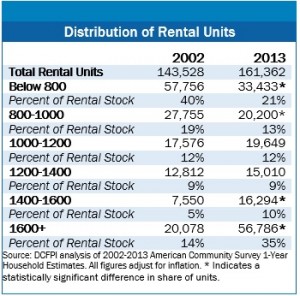Sharply rising rents in the District have led to the virtual disappearance of low-cost private housing across the city, according to a new analysis by the DC Fiscal Policy Institute. Yet the District’s economy has left nearly half of its residents with stagnant incomes. As a result, a growing number of residents are forced to spend the majority of their income on rent and utilities, struggling each month to maintain stable housing and afford other necessities like food and transportation.
The new DCFPI report, Going, Going, Gone: DC’s Vanishing Affordable Housing, highlights the urgency of finding solutions to the District’s housing crisis. The Mayor and DC Council need to greatly increase investments to preserve the affordable apartments we have and to add new affordable housing to maintain the city’s economic vitality.

- The number of low-cost apartments dropped nearly in half. The number of apartments with monthly rent and utilities below $800 fell from 58,000 in 2002 to only 33,000 in 2013, according to the report’s analysis of U.S. Census Bureau data.
- It now appears the private market has very few, if any, low-cost units. The number of apartments with monthly costs below $800 roughly matches the number of federally and locally subsidized housing units. This suggests that subsidized housing is now virtually the only source of inexpensive apartments.
Rents have risen rapidly for virtually all residents. The impact has been greatest on low-income households who have not benefited from DC’s recent economic growth. Increasingly, moderate-income households also struggle to afford rent and utilities.
- Two-thirds of low-income households — with incomes under $32,000 for a family of four — spend more than half their income on housing.
- Even renters with incomes up to $54,000 are struggling, as one in three of these households pays the majority of its income towards rent.
The lack of affordable housing affects the ability of residents to thrive and the city to remain economically strong. Families that spend the majority of their limited budget on housing costs are forced to cut other necessities like food, health care, and transportation. The high cost of housing leads families to live in substandard housing, with problems like mold or rodents, and forces many to move frequently. Unstable and unhealthy housing puts stress on families that makes it hard for children to focus at school and for parents to keep a job, and leaves many at risk of homelessness.
The District’s leaders need to actively pursue policies that keep the few affordable apartments that remain available, while also adding to the supply of low-cost rental options. This includes funding important programs like the city’s local rent supplement program and the Housing Production Trust Fund. This could also mean strengthening Inclusionary Zoning rules so that new housing developments include more affordable options for low- and moderate-income residents.
To read the full report, click here.
To print a copy of today’s blog, click here
.
